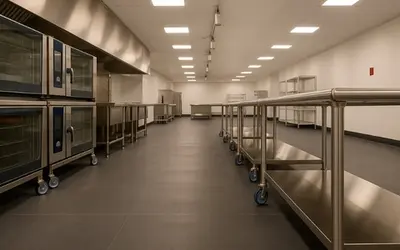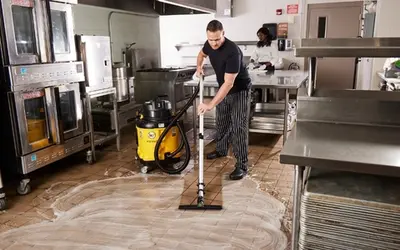The Best Way to Clean a Countertop

No one wants to eat at a dirty countertop. Stained and sticky with crumbs wedged into the seams, a dirty countertop is more than unpleasant. It might harbor dangerous germs and pathogens that can make customers sick. In fact, the CDC reports that restaurants are linked to more than 50% of foodborne outbreaks.
True, most of that threat comes from poor food handling practices, but improper countertop cleaning only adds to the problem. And that’s true for the back-of-house, kitchen prep areas too.
Maintaining countertops doesn’t have to be hard or time consuming. So, put down that rag and keep reading to learn the best way to clean a countertop.
Materials Matter: What Countertops are Made Of
Restaurant countertops take a beating. A countertop has to be robust, functional and good looking, whether it’s a fancy bar in the front of the house or a busy workstation in the back. Luckily, there’s a variety of countertop materials that meet that criterion.
Some common countertop materials include:
- Granite: A gorgeous, high-end choice, granite countertops are scratch resistant and hold up well to heat. Granite countertops are perfect for customer-facing environment and also perform well in the busiest kitchen setting. Note that granite is porous and requires sealing to prevent stains.
- Solid Surface: Solid surface is non-porous and seamless and an easy, low maintenance choice. The material comes in a wide variety of colors and patterns and can even be cut, drilled or sculpted to fit any decor. Be warned, solid surface may scratch and is not very heat resistant.
- Laminate: Laminate’s biggest selling point is affordability. It’s inexpensive to purchase, install and maintain. Therefore, it’s the perfect choice for a restaurateur on a tight budget. The material comes in a wide variety of attractive colors and patterns and is very easy to maintain.
- Stainless Steel: Stainless steel is strikingly elegant and modern. Plus, it is as robust as it is good looking. The material easily holds up to heat, acid and oil spills. Furthermore, it can be installed in one piece, so there’s no seams to catch crumbs and harbor germs. The material does scratch over time.
Is Your Countertop Clean?
Cleaning a countertop seems intuitive. Grab a rag or sponge, a bucket of soapy water and get wiping. This tried-and-true method leaves surfaces looking nice, but are they clean?
No, they’re not because the rag or sponge itself isn’t clean.
Rags are “… ideal placed for pathogens to multiply,” according to the Michigan State University Extension web page. They provide the perfect warm, moist, food-rich environment to host all kinds of bacteria like campylobacter, salmonella, staphylococcus, E. coli, and listeria – all of which can cause mild to severe intestinal and skin infections.
The page specifically warns against using sponges and rags on countertops as they greatly increase the chance of cross-contamination by spreading large quantities of bacteria on a surface. Plus, a rag gets dirtier with use, so the last surface cleaned can have two to eight times more dirt and contaminants than the first.
Instead, they suggest single-use paper towels or a disinfectant wipe. But realistically, how many busy restaurants, bars or kitchens are going to do that?
So, it’s back to the rag and bucket of soapy water. Or maybe a rag and spray bottle of chemical cleaner. Either way surfaces are left with a film of dirt, bacteria and unpleasant cleaning chemical residue.
The Best Way to Clean and Disinfect
Try a KaiFly™ system instead. This system comprises a microfiber trowel, window squeegee and high quality to remove 99.9% of bacteria quickly and easily.
Simply spray diluted cleaning chemical directly on the microfiber pad, wipe the counter with the pad and then follow up with the hand held window squeegee. Surfaces are left clean, dry and ready to use.
KaiFly is even effective without chemical cleaners. It removed greater than 99.9% of targeted bacteria from surfaces when used with plain tap water only in tests conducted by an independent NELAP-accredited laboratory. KaiFly is qualified, as a result, to be labeled as a sanitizing device. This is an EPA-regulated term for a device that works by physical means (such as mechanics) and does not contain a substance, such as a sanitizer or disinfectant, to perform its intended pesticidal purpose.
Want to learn more about the best way to clean a countertop? Click here.
Related Posts

Floor Cleanliness and Food Safety Scores
Poorly maintained floors are unsafe and unsanitary. They hold standing water, harbor pests, and cause slip, trip, and fall accidents. Here’s how to improve floor care and your food safety scores.
Read more
Beyond the Restroom: Kaivac for Fast, Easy, and Complete Kitchen Floor Care
You already know and trust Kaivac for restroom care. Our No-Touch Cleaning® systems make the unpleasant task of servicing restrooms fast, easy and complete. But did you know Kaivac has cleaning machines for every kind of floor?
Read more
UniVac Streamlines Kitchen Cleaning Process; Delivers Superior Results
Cleaning the kitchen floor is your employee’s most dreaded task. They face a physically demanding, multi-step, multi-tool, cleaning and degreasing process. It’s time to improve your process. The UniVac from Kaivac streamlines and standardizes kitchen floor cleaning, delivering superior results every time.
Read more